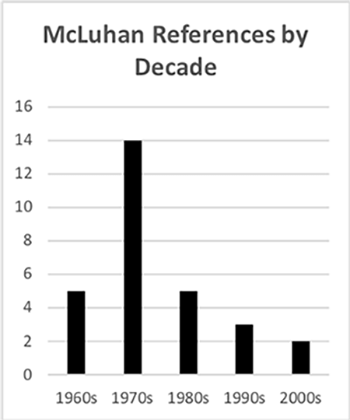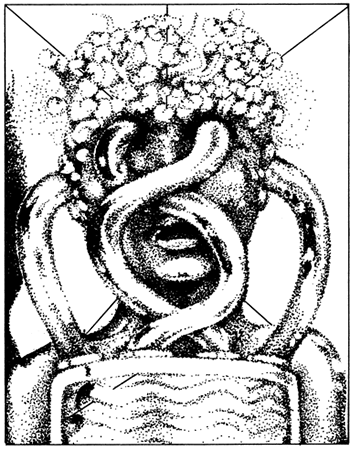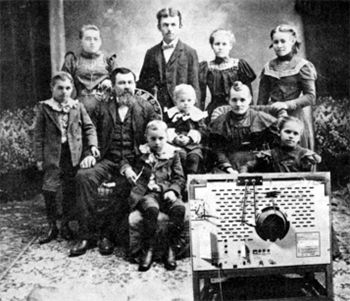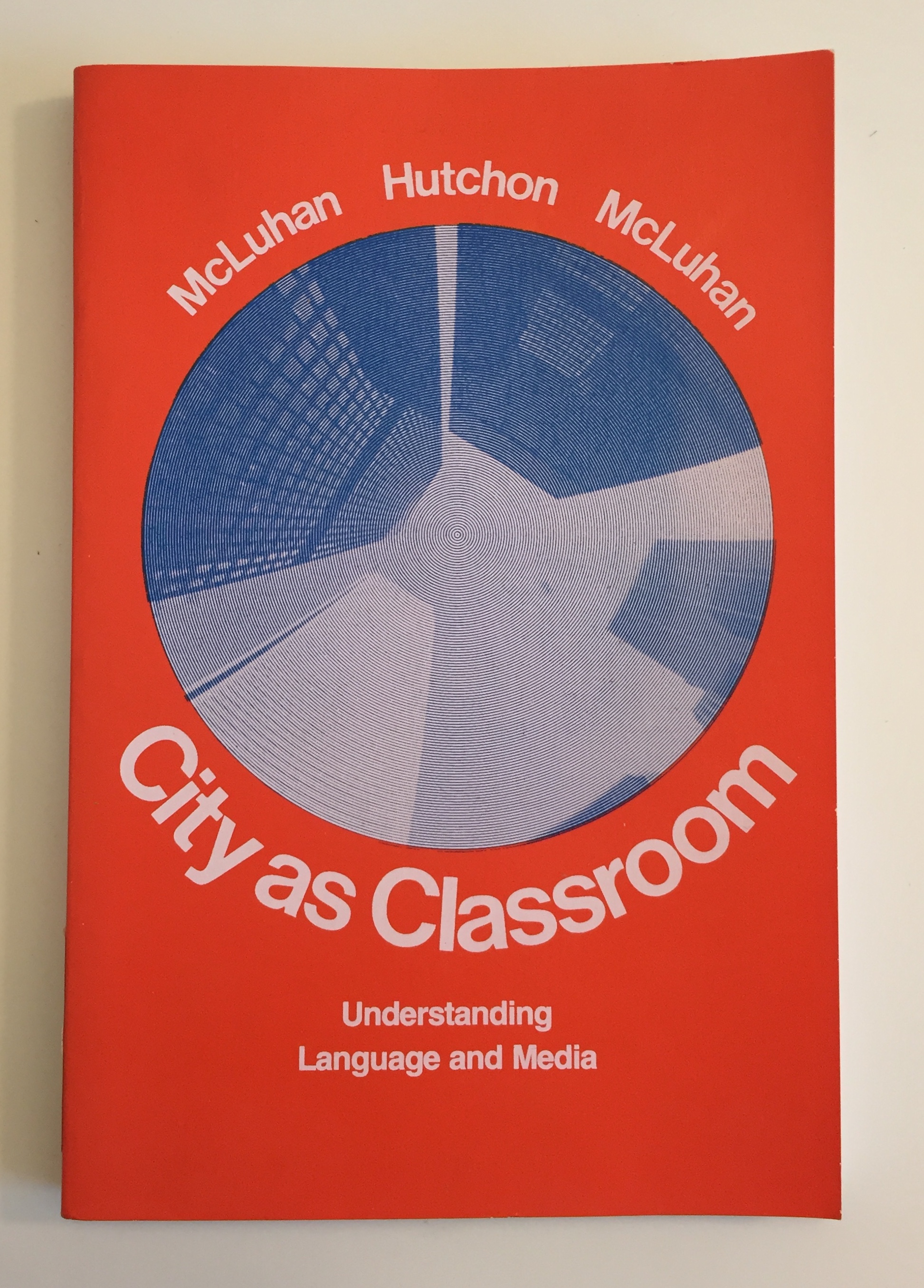Remembering the “perils” of Television
McLuhan Redesigning Pedagogy
“Anyone who tries to make a distinction between education and entertainment doesn’t know the first thing about either.”—Marshall McLuhan
One of the most noteworthy intellectual standouts mentioned throughout our entire corpus, literary figures notwithstanding, is the firebrand media theorist Marshall McLuhan. This is hardly surprising. McLuhan rose to prominence starting in the 1960s as an evangelist of popular culture (during a time when such an opinion was deemed somewhat controversial). He even went on to become something of a pop culture trope himself, a name invoked to conjure up the sense of disruption and transformation brought about by new communication technologies. And even though his fame largely coincided with the advent of the television age, his reach extended to include a much more comprehensive study of media ecologies.
In fact, McLuhan was even featured himself in 1978 as an invited author in the very pages of English Journal, joined by coauthors Kathryn Hutchon and son Eric McLuhan in “The Laws of the Media.” This article was primarily a description of their recently published The City as Classroom: Understanding Language and Media (1977), a textbook designed to encourage undergraduate and advanced high school students to explore how urban spaces are mediated in ways that they might not readily notice. We’ll have more to say about that a little later, after we first explore the various ways that English teachers drew upon the ideas of McLuhan in their own work.
McLuhan in English Journal
While McLuhan figures prominently in this chapter on television—in fact, we’ve even reimagined him as the star of an imaginary television series in our TV Talk section (an homage we like to think he would appreciate)—the impact of his thinking, both within and outside of the English Journal corpus, reaches far beyond that. Truth be told, McLuhan’s influence spills beyond the boundaries of our framing in this chapter, beyond the warm, cathode-ray-tube glow of the television screen. His influential 1964 book Understanding Media positioned TV as part of a much larger ecology of electronic mass media, including radio and film, that helps generate expanded cultural impact; this comprehensive way of thinking about media is reflected in how English teachers incorporated his theories into their teaching praxis.
A quick review of our corpus shows the span of McLuhan’s reach. Including the aforementioned article “The Laws of Media,” McLuhan is referenced in a total of twenty-nine articles. The most prominent media focused on in these articles were television (eight), film (eight), and computer (six)—alongside a wide range of other infrequently mentioned media that include live performance, board games, and audio tapes. In other words, McLuhan was widely cited across the spectrum of media types, with the exception of audio-related technologies, which is partially explained by the fact that many of the audio-related articles predate his rise as a prominent intellectual figure.

When we look at the number of articles by decade, we notice that the 1970s in particular stands out as the McLuhan decade, with references to him tapering off in the eighties and nineties (likely because his insights had become commonplace by that time, not to mention extended upon by others). The prominence of McLuhan in the 1970s also likely partly explains why “media” was such a frequently occurring word in that decade.
Another interesting observation from this data analysis is that McLuhan was more often cited in articles emphasizing reception over production: nineteen articles were reception oriented, compared to ten that foregrounded production. This bias toward understanding media through careful examination, ironically, is somewhat at odds with the playful, experimental approach to manipulating and making media content that McLuhan and his coauthors would promote in their own textbook.
Once we look a little more closely at the individual articles themselves, we notice some revealing trends that potentially complicate the true reach of McLuhan’s influence. For one, many of the articles only mentioned McLuhan briefly before going on to discuss their own approaches to incorporating media into the English curriculum, regardless of what that approach might be. Many of these references were little more than in-passing allusions to the media theorist (Carrico 1967; O’Keefe 1971; Cromer 1977; Foster 1987; Costanzo 1988). For example, in 1971, Patrick O’Keefe described embarking on a “McLuhan adventure” with his sophomore students in Niagara Falls, New York. This adventure involved making a silent film version of Shirley Jackson’s “The Lottery,” an assignment framed largely as a means of reinforcing traditional language arts objectives rather than considering how McLuhan’s theory might require more radical rethinking of the goals of English education (957–958). Jim Cromer (1977) similarly drew upon McLuhan’s claim of language as “man’s [sic] richest art form” (97) to argue that mass media have eroded students’ competency with verbal and written expression, arguing among other points that, “Our young have begun to view the intermedia world of video, film, and radio as the ‘real’ world rather than an edited, produced, directed, and created reality of the flat, homogenized screen” (99)—a conservative reaction to media change at odds with McLuhan’s own sense of how television was a cool medium promoting more participatory engagement among the youth. Making the case for students to learn to analyze the emerging popular “teenpic” film genre, Harold Foster (1987) cited McLuhan and Fiore’s The Medium is the Massage to argue that simply dismissing such films would only promote ignorance (Foster then went on to talk about examples of such films primarily in terms of literary concepts such as theme, character, and even moral values) (86). In a somewhat more complex engagement with McLuhan, William Costanzo (1988) briefly referenced McLuhan’s “the medium is the message” aphorism to contend that an in-depth study of the formal workings of media technology—particularly television and computers—would yield productive insights into how these tools helped give both literal and figurative shape to our language and thinking, or in his words, “new metaphors for language, new models for the mind” (32). One consistent element among the articles that did little more than name-check McLuhan is their inconsistency regarding the type of pedagogy they were supporting. These authors utilized McLuhan’s reputation for very different ends, some of which seem either opposed or tangential to McLuhan’s own thinking. (For example, McLuhan makes an odd spokesperson for calls to privilege traditional print literacy values).

There were English Journal authors who invoked McLuhan in more substantive ways, however, and sometimes even in the service of truly innovative teaching practices (Bronson 1968; Lucking 1974; Clarke 1974; Krekeler 1976). David Bronson’s 1968 article “Reading, Writing, and McLuhan” offered a relatively deep engagement and critique of the media theorist’s framing of reading and writing vis-à-vis other media. Although he took issue with McLuhan’s celebrity-like status in the business world and popular culture, Bronson argued that for all of McLuhan’s surface-level glitz and glamour, his theories were invaluable for better understanding the role of alphabetic reading and writing in the era of mass electronic media. According to Bronson, McLuhan raised fundamental questions about the “unnaturalness” of reading and writing that, thanks to the proliferation of television and other mass media, we have forgotten over the years (1151). For Bronson, the new media landscape presented occasion for reexamining the role of print, to recognize the unique place it occupied within that landscape as a medium: quiet, inwardly contemplative, atemporal, “as cool a medium as there is” (1154–1155). By thinking critically about print’s unique affordances as a medium, Bronson argued that students could be taught more robust critical reading skills, not to mention a greater appreciation of the written message.
While Bronson’s opinion piece functioned as a somewhat conservative encomium of the unique virtues of alphabetic text, other teachers drew upon McLuhanesque concepts to promote robust media production, sometimes in ways that were quite striking (and even remain so by today’s standards). Robert Lucking (1974) referenced McLuhan in conjunction with a television-focused curricular vision that incorporated the analysis of television programs, commercials, and even network infrastructure in addition to collaborative TV production. Bemoaning the existence of underutilized AV equipment in contemporary high schools, along with the narrow sense of audience that came with having only the teacher read student writing, Lucking put forth this vigorous defense for composing for the small screen:
More than studying content and programming, English teachers can also profit by dealing with the massage—how television works on our senses and kneads our reactions. Because TV stimulates several of our senses simultaneously, it becomes an environment we put on; it demands a certain participation. As Marshall McLuhan has suggested, young people have become acclimated to these forces and are now seeking a role of involvement; they quickly become dissatisfied with passive learning situations. Electronic media develop a sense of intimacy and simultaneity which carry direct implications for teaching. The astute teacher who wants as much participation as possible can have students shoot their own television productions. (75)
In this way, Lucking powerfully recognized that students might best come to appreciate McLuhan’s vision of television as a participatory, “cool” medium if they had a chance to make television programs themselves.

Drawing on McLuhan’s elucidation of the power of media to influence thought and emotion, John Clarke (1974) led his eleventh-grade students in a multimedia design project based on Orwell’s 1984 that incorporated audio players, slide projectors, and televisions in order to replicate the novel’s “One Minute of Hate” propaganda programs. The purpose of this assignment, as Clarke explained, was to raise critical awareness of students’ local media landscape: “As Marshall McLuhan pointed out, all the media regulate in a particular way the interactions which take place between humans and themselves. They control the intensity and pace of the exchange” (51). Clarke’s assignment accomplished a number of interrelated goals, having students engage in close reading and interpretation of a literary text, translate that reading into a creative transmedia performance, and critically reflect on the rhetorical potential of mass media to influence and persuade an audience, sometimes in ethically questionable ways.
In perhaps the most striking example of McLuhanesque pedagogy in the corpus, Eliza Krekeler (1976) drew on the work of McLuhan—whom she dubbed “the Electronic Oracle himself” (58)—in order to develop a radical pedagogy inspired by the performance-based multimedia “happenings” of the 1950s and 1960s avant-garde art scene. Seeking to engage her TV-era high school students, Krekeler offered a jaw-dropping description of her high-concept, low-tech assignment, “See the Light: An Electronic Happening,” which involved students working collaboratively to create an annual media show for their fellow schoolmates and teachers. “See the Light” consisted of a barrage of mediated artwork, including dynamic multicolored transparencies projected onto walls, ready-made kinetic sculptures crafted from discarded television sets outfitted with strobe lights and various classroom objects, and the sounds of typewriters and Pink Floyd synchronized to oscilloscope displays. In support of this pedagogy, Krekeler quoted McLuhan’s prescient statement in The Medium is the Massage:
The young today live mythically and in depth. But they encounter instruction in situations organized by means of classified information—subjects are unrelated, they are visually conceived in terms of a blueprint. Many of our institutions suppress all the natural direct experience of youth, who respond with untaught delight to the poetry and beauty of the new technological environment, the environment of popular culture. (McLuhan quoted in Krekeler, 58)
In addition to embracing McLuhan’s “untaught delight” of exploring this new media environment, a central goal of Krekeler’s electronic happenings was to challenge the traditional separation of distinct disciplines and media in education. Seemingly channeling McLuhan directly, Krekeler wrote: “Before I built a curriculum wall, I'd ask to know what I was walling in or walling out. There is no room for barriers in our technological world in which artists are design engineers, scientists are aestheticians, and poets are typographical artists” (59). Unapologetically and enthusiastically multidisciplinary and multimediated, if “See the Light” were to be replicated in today’s English classroom, it would certainly challenge and delight artists and audience alike. (If any of you dear readers are inspired to try it, please invite us to Skype or Zoom in!)
It’s clear that McLuhan was hardly a monolithic figure within the English Journal corpus. When authors reached for his name, it was for various ends, reflecting the ambivalent push and pull of English teachers coming to terms with emerging media. In a sense, McLuhan functioned as an overdetermined symbol of the media age, a figure who could be called forth to help support pedagogical arguments ranging from the conservative to the radical. Even when citing him favorably as a bastion of media theory—or at least ostensibly so—these broader arguments were not always aligned with the more radical rethinking of education he was calling for. Regardless of the pedagogical spectrum represented within this subset of articles, we nevertheless see within it the common denominator of McLuhan’s lasting influence: encouraging English teachers to reckon with the mediated nature of our contemporary cultural landscape, to think of media as media.
McLuhan’s Pedagogy in City as Classroom
Perhaps the best elaboration of the pedagogical aspects of McLuhan’s theorizing can be found in his coauthored textbook, City as Classroom (McLuhan, Hutchon, and McLuhan 1977), which he and his coauthors discussed on the pages of English Journal in 1978. City as Classroom was a rather innovative textbook for its day, an attempt to encourage students to engage in collaborative, exploratory activities using creative play, experimentation, media production, and analysis to better understand the complex and interrelated nature of the myriad mediated texts circulating in an urban setting (with, unfortunately, no mention of what students in rural areas were supposed to do). The introduction began with a kind of exhortation to the students to abandon the stale, ineffective classroom (likened to a prison) and take to the city streets, which offered modern students a far more robust, relevant laboratory for learning about the world around them (1–5). Although English Journal authors tended to look to McLuhan to inform their thinking about major media such as television, film, and, later on, the computer, City as Classroom offered students a fairly comprehensive list of categories for what counts as media, including television, radio, print, motor cars, light bulbs, satellites, telephones, clocks, and money, to name but a few.

As the authors explained, City as Classroom positioned the student as a kind of “media spy” trained in the arts of covert observation: “The world of observation includes the entire area of literary and media study, since literature and media require much training in perception and critical awareness” (McLuhan, Hutchon, and McLuhan 1978, 92). In that spirit, the book offered several highly imaginative prompts for its readers, such as encouraging them to manipulate the various knobs of a television set (e.g., white balance, vertical hold, color) in order to consider how they might “remix” TV content (72–73). Another activity encouraged students to produce “family portraits” or “sound pictures” of their home environments using nothing but audio tape recorders (96). Still another activity asked students to explore all the ways that the invention of the airplane has changed the areas of industry, economy, politics, and culture (113–114).
Central to the observation-based activities suggested in City as Classroom is what the authors called figure/ground analysis, a critical framework adapted from early twentieth-century psychologist Edgar Rubin’s vocabulary designed to more precisely describe visual phenomena (8–9). Essentially, figure/ground analysis prompted students to think about discrete media texts as they exist within a larger milieu of additional media, cultural contexts, and other elements. As the textbook explained, “Therefore, the ground, or underlying structure, of a situation provides the conditions for experiencing any part that presents itself as figure” (14). For example, the textbook suggested taping a student performing a speech (figure), but reacting in various ways off camera “with jeers, clapping, boos and cheers” (ground), and then observing how such manipulations affect the performance (16). Another suggested figure/ground activity involved having two groups of students seated in a classroom waiting for a guest speaker (figure), one group in a room lit with harsh fluorescent bulbs, the other group in a room with softer incandescent lighting (ground); observers were then to time how long it took until the students began talking with one another (17). Activities such as these demonstrated how the figure/ground framework was conceived as more than a descriptive analytic. It also served as a heuristic for creative manipulation or remix aimed at making structural components usually rendered less visible by their background status more prominent, thus allowing students to think more deeply about why and how media were structured the way they were.
The book ended by motivating the reader to take the lessons learned from the textbook beyond the designated educational experience, a kind of encouragement for continuing education. It advised exploring figure/ground relationships in areas not previously mentioned, including the world of advertising, slang, and even cultures around the world. Perhaps a bit ahead of its time, City as Classroom was not necessarily a widely adopted book, so the promise it showed to potentially disrupt teaching went largely unfulfilled (Dowd 2018, 105).
The death of McLuhan on the final day of 1980 did not, however, represent the death of his influence on English pedagogy. In our next chapter, which focuses on computer pedagogies, we again notice the return of McLuhanesque global village rhetoric, the wide-eyed, hyperbolic idea that international connectivity and increased interactivity will have transformative, democratizing effects on students, and society at large. In particular, this return of global village rhetoric coincided with growing access to the internet and other networking protocols in the late eighties and early nineties, attracting the attention of English teachers eager to do more with computers than word processing. Over time, however, as the World Wide Web grew into an increasingly commercialized and corporatized medium, that enthusiasm became tempered by more critically nuanced viewpoints.
